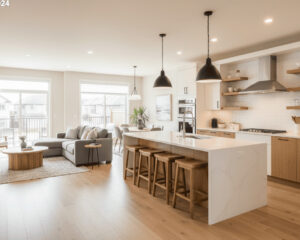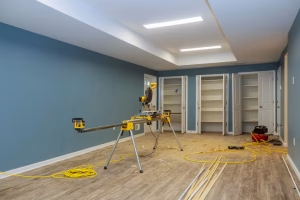Renovating your home in Edmonton is exciting, but good results start with smart home renovation budgeting. Whether you’re updating a kitchen, finishing a basement, or refreshing bathrooms, clear financial planning keeps the project on track, reduces stress, and helps you make choices that last through Alberta’s seasons.
This guide walks Edmonton homeowners through practical budgeting techniques: how to set priorities, how to plan for permits and trade schedules, how to avoid common money traps, and how to work with a contractor who provides clear, lender- and permit-ready documentation. Along the way, I’ll share local references, credible Canadian data, real project examples from Edmonton neighbourhoods, and expert tips from Steadfast Constructions Ltd., a local contractor that helps homeowners with planning, permits, and project delivery.
Start with goals, not numbers.
The strongest budgets begin with a clear statement of goals. Start by answering: What do you need from the renovation? What do you want? Which outcomes are non-negotiable?
Define priorities.
List your objectives in three tiers:
- Must-haves: items that affect structure, safety, or code compliance (for example, fixing a failing floor structure or addressing ventilation).
- Nice-to-haves: design features that improve day-to-day use (better storage, a new tile layout, improved fixtures).
- Future upgrades: items you’d like later but can defer (luxury finishes or optional tech).
Working from priorities helps your contractor make smart substitutions if supply or scheduling changes are needed. It also keeps your budget focused on outcomes that matter most to daily life and resale. A clear priority list will also be valuable when you sit down with lenders or apply for program support. CMHC
Research the local market context first
Understanding the local renovation market helps you plan realistic timelines and choose procurement strategies.
What Edmonton homeowners should know
National and regional data show the renovation market is active and that contractor pricing can shift with demand and material availability. For example, Canada’s residential renovation price indexes are published quarterly, so homeowners can track how contractor prices are moving in their region; watching those trends helps with planning timing and material choices. Statistics Canada
Local takeaway:
- Expect some variation in lead times for specialty items and licensed trades.
- If you want a particular material or fixture, order early in the design process.
- Ask your contractor about local supply patterns; they work with suppliers daily and can suggest alternatives that preserve the look without compromising longevity.
Build a realistic scope with your contractor.
A detailed scope is the backbone of home renovation budgeting. The more specific the scope, the easier it is to get accurate quotes and avoid surprises.
What a good scope includes
Ask your contractor to produce a scope document that covers:
- Work to be completed (clearly itemized).
- Work that is excluded (to avoid assumptions).
- Materials specifications (brand or performance objectives, not just style).
- A project timeline and key milestones tied to inspections and trades.
- Any permit requirements and who will apply for them.
Steadfast Constructions Ltd. provides permit-ready drawings and written scopes that lenders and municipal reviewers prefer. This clarity helps everyone understand what the project will deliver and makes budgeting much more reliable. City of Edmonton
Plan for permits, inspections, and timelines
Permits and inspections protect your property and resale value — but they also affect timing and cash flow.
Permit-ready planning matters
In Edmonton, work that alters structure, plumbing, HVAC, or electrical systems typically requires permits. Starting work without the correct permits risks stop-work orders and costly corrective steps. Include permit fees, inspection windows, and potential rework time in your schedule, and make sure your contractor knows the municipal process so timing is not a surprise. City of Edmonton
Practical step: Request a permit checklist from your contractor early. Align financing draws or staged payments with inspections and milestone approvals to keep funds matched to progress.
Manage risk with contingency and sequence planning.
Every renovation has unknowns; the best budgets account for them.
Contingency planning without guessing numbers
Rather than using arbitrary buffers, plan contingencies around specific risk categories:
- Hidden conditions: things uncovered during demolition, such as water damage or older wiring. Plan how you’ll decide whether to fix or defer.
- Permit-related changes: design changes required by inspectors or code clarification.
- Supply chain delays: which affect finish availability and schedule.
Work with your contractor to identify the top risks for your project and agree on decision protocols (for example, who authorizes a change order and how changes will be priced). Clear communication reduces unexpected costs and helps you decide quickly when a trade proposes an unavoidable fix. Steadfast Constructions’ project managers routinely document decision points so homeowners see the trade-offs before committing. CMHC
Prioritize value and longevity over trends.
Spending on durable, climate-appropriate materials often reduces lifetime costs and frustration.
Choose materials for Edmonton’s climate.
Edmonton’s seasonal swings mean materials that resist moisture and temperature changes perform better over time. Consider:
- Engineered woods or sealed joinery in areas exposed to humidity.
- Low-porosity tiles and proper subfloor assemblies in lower-level baths.
- Durable hardware finishes that stand up to high-use environments.
Making choices that are a touch more pragmatic up front reduces the chance of repair or premature replacement, a key principle in smart home renovation budgeting. Steadfast Constructions advises on assemblies that are proven in Alberta’s climate, so aesthetic choices don’t compromise performance. Statistics Canada
Reduce scope creep with clear decisions and allowances.
Scope creep, small additions that pile up, destroys budgets.
Use allowances and approved-upgrades lists.
When some finishes are undecided at the contract stage, use allowances for those items: a clearly defined placeholder that lists the performance or style standard (for example, “vanity — mid-height with soft-close drawers, laminate finish”) rather than an exact model. When you choose the final product, your contractor replaces the allowance with the chosen item and documents any price change.
To limit decisions during construction:
- Finalize as many selections as possible before demolition.
- Define which selections are flexible and create an approvals process for any requested on-site additions.
This approach keeps procurement predictable and helps the contractor lock in delivery schedules and prices with suppliers.
Use a procurement strategy to save time and headaches.
How you buy materials affects schedule and budget certainty.
Buy long-lead items early.
Certain items custom cabinetry, specialty tiles, and engineered slabs, have longer production and delivery times. Identify these early and order them once the design is confirmed. This avoids stalled trades and emergency substitutions that drive up costs and disrupt schedules. Your contractor should provide lead-time guidance and align ordering with deposit milestones.
Consider local suppliers and warranties.
Local showrooms and suppliers often offer quicker turnaround and easier warranty handling. Steadfast Constructions works with trusted Edmonton suppliers who understand local conditions and can help with selections that deliver both the look and durability you expect.
Financing and cash-flow alignment
Matching payment structure to project sequencing keeps cash flow steady and avoids borrowing more than necessary.
Aligns with verified milestones
When financing with a lender, or even with a HELOC or line of credit, structure draws to match actual work stages: materials ordered, demolition finished, rough-ins complete, and final finishes installed. Require contractor invoices and, where appropriate, inspection sign-offs before releasing funds. This protects both parties and keeps the project accountable.
Steadfast Constructions can provide documented milestone reports that make lender draws straightforward and defensible.
Get multiple bids and compare apples to apples.
Not every low bid is a good deal.
How to compare bids properly
When you get multiple quotes:
- Ensure each quote uses the same scope and material standards.
- Ask for a breakdown of labour, materials, subcontractors, and allowances.
- Check contractor references and examples of finished projects in Edmonton.
- Confirm who obtains permits and how change orders are handled.
A well-documented, slightly higher bid from a reputable contractor can be a better value than a low price with unclear exclusions or missing trades.
Use grants, rebates, and tax-smart options where eligible.
Leverage programs that align with energy and performance upgrades.
Check federal and municipal support.
Programs like Canada’s Greener Homes initiative and City of Edmonton energy programs support eligible upgrades such as ventilation, insulation, and certain efficient systems. If your renovation includes these measures, register and follow program steps early—many require pre-retrofit assessments and specific product documentation. Using grants and rebates reduces the financing need and improves the overall project return. Natural Resources Canada
Practical step: ask your contractor which parts of your scope may qualify and coordinate the required assessments before work begins.
Communication, documentation, and change control
Good documentation prevents disputes and keeps the budget predictable.
Keep a project binder.
Track permits, contracts, invoices, product specs, and photos. Require written change orders for any scope change that includes a description, price impact, and schedule effect before work proceeds.
Steadfast Constructions provides clients with a final handover package that includes warranties, inspection records and care guidance, important documents for resale and maintenance.
Real Edmonton examples and lessons learned.
Practical examples help illustrate the principles above.
Lesson from a west-end kitchen rework
A homeowner in the west end prioritized a durable island and upgraded ventilation. By defining priorities early and ordering the island cabinetry first, the project avoided downtime while other trades progressed. The contractor’s clear scope and milestone invoices made lender draws and supplier payments simple.
Lesson from a south-side basement finish
A south-side homeowner wanted a flexible basement for guests and an office. The team grouped lighting and HVAC work into an early phase so the space was usable while finishes were chosen. This phased approach prevented rushed decisions and kept the project within the homeowner’s cash-flow plan.
Both examples underscore that careful sequencing, early procurement, and clear scoping are the most reliable cost-control tools.
Final checklist for Edmonton homeowners
Use this checklist to start your project:
- Define must-haves, nice-to-haves, and future upgrades.
- Schedule a site visit and request a detailed, permit-ready scope from your contractor.
- Identify long-lead items and order them once designs are final.
- Confirm permit needs and align your timeline with inspection windows. City of Edmonton
- Use documented allowances for undecided finishes.
- Align financing draws with inspection-linked milestones.
- Keep a project binder and require written change orders.
Working this way reduces surprises and makes home renovation budgeting manageable and less stressful.
Conclusion
Smart home renovation budgeting is about decisions, not just numbers. For Edmonton homeowners, success comes from defining priorities, working with a contractor who prepares clear, permit-ready scopes, planning procurement and sequencing, and using available local supports where applicable. That approach keeps the project resilient to supply and timing challenges and ensures the finished space performs in Alberta’s climate.
Steadfast Constructions Ltd. helps Edmonton homeowners at every step, from priority setting and permit-ready documentation to trade coordination and final handover. If you’re planning a renovation and want a practical budget plan that aligns with permits and lender requirements, contact Steadfast Constructions Ltd. for a consultation. We’ll help you scope the work, identify lead times and supports, and create a project plan that keeps your budget and schedule on track.
Frequently Asked Questions (FAQs)
Q1: What is the first step in home renovation budgeting?
A1: Start by defining goals: list must-haves, nice-to-haves, and future upgrades. A clear priority list helps your contractor create a detailed scope, which is the foundation of a reliable budget.
Q2: Do I need permits for common renovation projects in Edmonton?
A2: Many renovations that change structure, plumbing, HVAC, or electrical systems require permits in Edmonton. Check the City of Edmonton’s renovation and permit guides early and ask your contractor to include permit planning in the scope.
Q3: How do I manage the risk of unexpected repairs during renovation?
A3: Identify likely risk areas with your contractor, plan specific contingencies, and set decision protocols for change orders. Avoid arbitrary buffers and focus on named risks and pre-approved decision thresholds instead.
Q4: Can government programs help with my renovation budget?
A4: Yes, programs that support energy- or performance-focused upgrades (for example, federal and municipal initiatives) can reduce the amount you need to finance. Coordinate required assessments and documentation before work begins to maintain eligibility.
Q5: What should I include in a contract to protect my renovation budget?
A5: A clear contract should list the full scope, exclusions, material specifications, milestone payments, permit responsibilities, and a change-order process. Keep all permits and invoices in a project binder for accountability and resale documentation.







